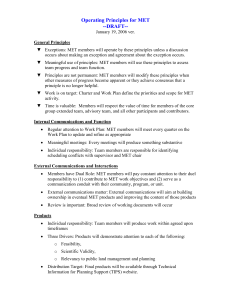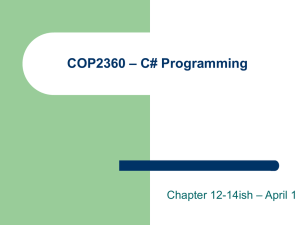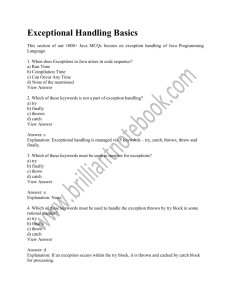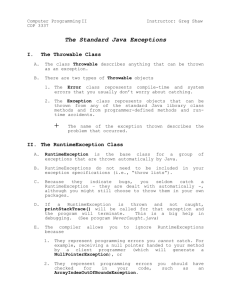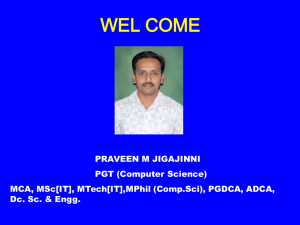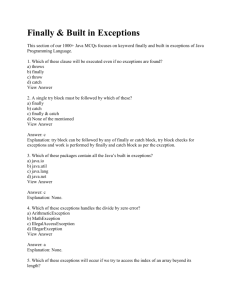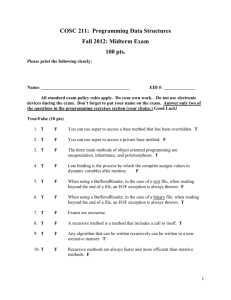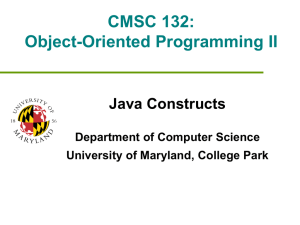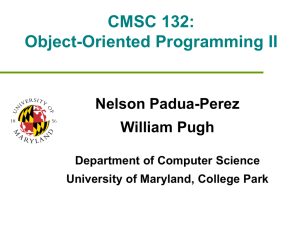xi_11_programming guidelines_ip
advertisement
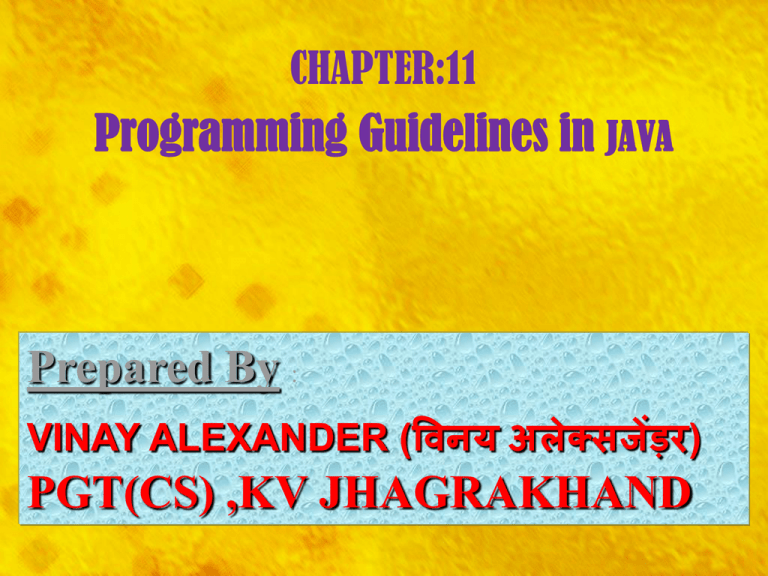
CHAPTER:11
Programming Guidelines in JAVA
Prepared By :
VINAY ALEXANDER (विनय अलेक्सजेंड़र)
PGT(CS) ,KV JHAGRAKHAND
Objective
In this presentation you will learn about
the
various
guidelines
regarding
development of a good program.
Understanding goodness of a program
Steps to develop a Program.
Errors classification and understanding
Program Testing
Documentation
STYLISTIC GUIDELINES
Meaningful names for identifiers
Identifiers identify different parts of Java programs.
Identifiers should have meaningful names.
Guidelines followed while dealing with identifiers-
Assign meaningful names for all identifiers.
That is Variable, Class and Methods.
Do not use similar looking names e. g .,manage
,manager.
Always assign names to scalar constants
(created with final keyword) as it helps in clarity
& readability.
Ensure Clarity of Expressions
Expression in the program should be written
clearly. Proper parenthesis may be used to
enhance the clarity of the expression.
Avoid programming tricks whose intent will
not be obvious to a reader.
Use standard methods in to enhance
readability e.g. ,use Math . sqrt ()
to
calculate square root rather than writing
your own logic for it.
Use Comments & Indentation
Comments play very important role as they
provide internal documentation of a program.
Indentation makes the statements clear &
readable.
JAVA comments are given either by //or
/*....*/brackets
1.Always insert
prologues , the comment in the
beginning of a program.
2.Insert explanatory comments where ever applicable.
3.Use comments to help identify {…}pairs greatly &
enhance program understanding.
4.Always indent statements to highlight nesting of
groups of control statements.
The insertion of blank lines & blank
spaces:
Blank
lines can inserted before
the declaration of blocks,
comment
lines,
method’s
prototype etc. It increases
readability. Space must be
given before and after an
operator to make it more
readability..
Statement Formatting
Program should be pretty typed
i.e. All the statement must be
written in separate lines. So that
program may be readable and
understandable.
When program is formatting is
done to make a program more
readable,
it
is
called
prettyprinting.
Characteristics of a Good program
A good Program not only efficiently solves the
given problem but also it should be presentable.
The following features are expected for its
goodness Effective and efficient: The program produces
correct results and is faster, taking into account
the memory constraints
User Friendly: The program should be user
friendly. The user should not be concerned
about what is happening inside the program.
The user should be only responsible for
providing the input data values and rest
everything be the program’s responsibility.
The output provided by the program should also
be easily understandable and presentable.
Self-Documenting Code: The source code
of the program should have meaningful
names for Identifiers and Variables, and
proper comment should be used to make
it self-documenting.
Reliable: The program should be reliable
i.e. it must be able to handle unexpected
situation like wrong data or no data. The
program should display proper error
messages.
Portable: A Program should be portable
i.e. It can run on different Hardware and
software platform.
STAGES OF PROGRAM DEVELOPMENT PROCESS: A
program development problem is a step by step
process where each stage contributes to building
of an effective and efficient program.
=> There are four stages in program development
process as given below:
1.Crack the problem: The problem is cracked and
an algorithm is formulated which gives the
solution for the problem.
2.Code the Algorithm: The algorithm should be
translated into the program(source code)carefully
to avoid errors that may crop up.
3.Compile the program: It is a process to convert
the source code into the object code and reported
errors should be rectified
4.Execute the program: At the run time ,errors if
any ,should be removed & 3rd stage should be
repeated
to compile & finally
execute the
corrected version of the program.
ROBSTNESS
The ability of a program, to recover following error &
to continue operating within its environment, is
Robustness.
GUARD CODE:
The code that can handle
exceptional data errors and operational errors is
called Guard Code.
Types of errors in the program
An error or ‘Bug’ is anything in the
program code that prevents a program to
run in correct manner.
compile-time errors: An Errors
that
occur during compiling-time ,are known
as compile-time errors.
Syntax Error: It is occurred when rules of the
programming language are not followed. It is most
common due to spelling errors in the Keywords
and methods.
Semantic Error: It is occurred when a statement
written is not meaningful.
Ex. X + Y = Z
Logical Error: When Program does not give
correct result due to mistake in the calculation or
use of operators etc. These errors are most
difficult to trace in a big sized program.
Run Time Error: This error occurred at Run-Time
and it is due to incompatible Data Types used, divide
by zero in the expression etc. which may cause the
termination of program execution abnormally.
Run time errors are also called exceptions, and
handling such errors in the application is called
exception handling
Exception : Unexpected situation or unexpected
error, during program execution is known as
Exception.
Exception
Handling:
Way
of
handling
anomalous situation in a program-run , is known
as Exception Handling
Advantages:
1. Exception Handling separates error-handling code
from normal code.
2. It clarifies the code and enhances readability.
3. It makes for clear, robust, fault-tolerant programs
Concept of Exception Handling
The raising of imaginary error flag is called
throwing an error. When as error is thrown , the
overall system responds by catching the error. And
surrounding a block of error-sensitive code-withexception-handling is called trying to execute a block
Exceptional Handling in Java: In java exception
handling is done using try{ } and catch{ } blocks.
Statements that can raise an error are placed inside
the try{ } block and its handling code is written inside
the catch{ } block.
if there are multiple exceptional classes that might
arise in the try block, then several catch block are
allowed to handle them.code must be executed no
matter what happens can be placed in finally block.
The thrown keyword: Keyword thrown is used to inform
that an error has occurred. It is specified with method
prototype. i.e.,
Public static void main(String[ ] args) throws IOException
Syntax:
try {
// tested statement(s);
}
Catch(ExceptionName e1)
{
// Trap handler statement(s);
}
Catch(ExceptionName e2)
{
// Trap handler statement(s);
}
Finally
{
// always executed block
}
try {
int age=Integer.parseInt(ageTF.getText());
}
Catch(Exception e)
{
JOptionPane.showMessageDialog(null,
“Enter a Numeric Value”);
}
PROBLEM SOLVING METHADOLOGY AND
TECHNIQUES
The following steps are taken while
designing a program1. Understanding the Problem
2. Analyzing the Problem
3. Designing the Program
4. Coding the Program
5. Testing & Debugging The Program
6. Documentation
7. Maintenance of the Program
1.Understand the problem: You must
recognize the need of program. Try to
explore ‘WHAT’ component in the problem
2.Analyse the problem :After determining
the need, carefully analyze the problem to
get an effective solution. Try to explore the
inputs to get required output.
3. Design the program: In this step ‘HOW’
component is explored. Try to find out the
bet sequence of steps (Algorithm) to solve
the problem. A big problem can be broken
in to smaller portion to get effective
solution.
4.Coding of Program: The translate your
solution into Programming Language. While
translating you need to identify the control
structure, arithmetic and logical calculations to
be used. An IDE (eg. NetBeans) can be used to
code the Program.
5.Test & Debug the program: Once a Program
has been coded, it can be executed and find
out the errors (Syntactical & Logical), if any.
The errors also termed as ‘bugs’.
Testing is the process of finding errors in a
program ,and debugging is the process of
correcting errors found during the testing
process.
6.complete your documentation: Documentation
helps to others to understand the program. Details
of the program including its source code,
Input/Output screen and its operating instructions
are recorded and compiled in the form of booklet.
7.Maintenance of the Program
Maintenance is required
To modify the program,
To remove the undetected errors or
To enhance the program functionality
To keep the program up-to-date with its
environment.
General Debugging Methods:
1. Create the main class first.
2. Test each method separately.
3. Trace code Blocks.
4. Insert debug code.
5. Test the program under different conditions.
Program verification
Program verification is the process of determining the
degree to which a software product fulfills its specification.
Types of Program verification
1.Deskchecking: It is a manually verifying of a program. the
essential data are written down and the programmer walks
the design as specified by the statements , making changes
in the data on the paper
2. Walk-through : a manual simulation of the program with
simple test input is performed , by a team keeping track of
the program’s data on the paper or on a black board. It is
not intended to simulate all possible test cases.
3. Inspection: A team carries out the inspection where a
reader reads the code line by line. inspection participants
point out errors that are recorded on an inspection report.
Program Testing
A Program must be tested to remove the
errors.
The following types of testing methods may be used.
1.Unit Testing: In this method, a single unit
(module or package) of the program is tested
to meet its specification. It is much easier to
test and debug a small module (units) one at a
time.
2.Functional (Black Box) Testing: The
functionality of the module or program is
tested by giving possible input values, treating
the code (program) as a “Black box” without
concerning its internal working.
3.Structural (White Box) Testing: In this
testing module or program is tested to trace
the all path of execution of statements in the
module. This technique is used to see the
structural behavior of the program.
4.Path Testing: In this technique, all the
possible paths of statement are tried to
execute by giving possible input values or test
cases.
5. Metric Based Testing: The goals are based
on certain measurable factors. These
measurements can also be used to indicate
when certain level of testing has been
completed
6.Integration Testing: This technique is
performed to integrate all the program
modules (units) that have been tested
independently in unit testing. It can be TopDown, Bottom-up or in combined approach.
DOCUMENTATION: A proper developed application
must be equipped with its explanations and descriptions
to facilitate users.
Documentation refers to written descriptions, design,
code and comment, internal and external requirement to
the
program,
which
make
a
program
more
understandable, readable and more easily modifiable.
MODULES OF DOCUMENTATION: Modules make
information easily accessible to the specific user for
which they were prepared and they reduce the costs of
production and maintenance.
The aggregation of modules and their details would
depend upon
1. Complexity of the system
2. Technical sophisticated of user
3. People involved in development and use
4. Expected life of documentation
The documentation module (also called
Manual) may be following types as per their
contents.
User Manual: Describes how to use the
program and contains all the I/O screens and
operating instruction for its user.
Operation Manual: Describes the various steps
to perform a specific task using the system.
Program Manual: It contains the Source code
of the program for reference purpose. It is
required during program Maintenance.
System
Manual:
It
contains
overall
specification, results of all the program
development stages etc.
Program Maintenance: Program maintenance
refers to the modification of a program, in
order to meet changing requirements or to
take care of undetected errors.
The following types of Maintenance may
occur:
Corrective Maintenance: It is required to
correct the errors which were undetected
during the design of the program.
Adaptive Maintenance: Change in user’s
need or program environment may occur and
program must be changed to adapt such
changes. This change in the program is called
Adaptive Maintenance.
Preventive Maintenance: Sometimes you
could anticipate the errors before they
actually occur. Preventive Maintenance is
carried out to avoid such errors.
Perfective Maintenance: To cope with
changing world i.e. changes in the
technology, you should tune your system
to keep it up-to-date. Due to arrival of new
technology and facilities, the program is
updated to make it perfect in respect of new
technological need.
